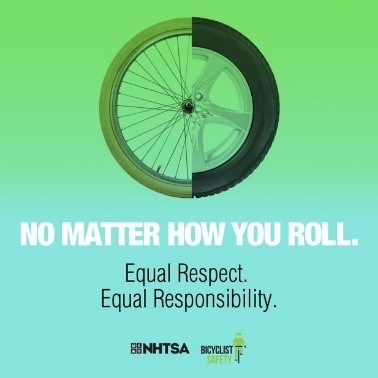Bicycle Safety on the Road:
There are two main types of crashes: the most common (falls), and the most serious (the ones with cars). Regardless of the reason for the crash, prevention is the name of the game. There are things you can do to decrease your risk of a crash.
- Regardless of the season, bicyclist deaths occurred most often between 6 p.m. and 9 p.m.
- Bicyclist deaths occur most often in urban areas (75%) compared to rural areas (25%) in 2017.
- Bicyclist deaths were 8 times higher for males than females in 2017.
- Alcohol was involved in 37% of all fatal bicyclist crashes in 2017.
Remember, all states require bicyclists on the roadway to follow the same rules (laws) as those operating a motor vehicle. It’s your job to follow the rules of the road.
Best Practice When Riding:
- Ride a bike that fits you—if it’s too big, it’s harder to control the bike.
- Ride a bike that works—it really doesn’t matter how well you ride if the brakes don’t work.
- Wear equipment to protect yourself and to make you visible to oncoming traffic, a good fitting bike helmet, bright clothing (day or night), reflective gear, and a white front light and red rear light and reflectors on your bike. This safety gear could save your life.
- Tuck and tie your shoelaces and pant legs so they don’t get caught in your bike chain.
- Plan your route—if driving as a vehicle on the road, choose routes with less traffic and slower speeds. Your safest route may be away from traffic altogether, in a bike lane or on a bike path
Stay Focused While Riding:
Be focused and alert to the road and all traffic around you; anticipate what others may do, before they do it. It is important to be on the defense when riding—the quicker you notice a potential conflict, the quicker you can act to avoid a potential crash.
- Drive with the flow, in the same direction as traffic.
- Obey street signs, signals, and road markings, just like a car.
- Assume the other person doesn’t see you; look ahead for hazards or situations to avoid that may cause you to fall, like toys, pebbles, potholes, grates, train tracks.
- No texting, listening to loud music or using devices that distract you by taking your eyes and ears off the road.
- Interactive Bike Map
- Nebraska Bicycle Map - Front
- Nebraska Bicycle Map - Back
- Bicycle Safety Brochure
Pedestrian and Bicycle Infrastructure Policy Overview

